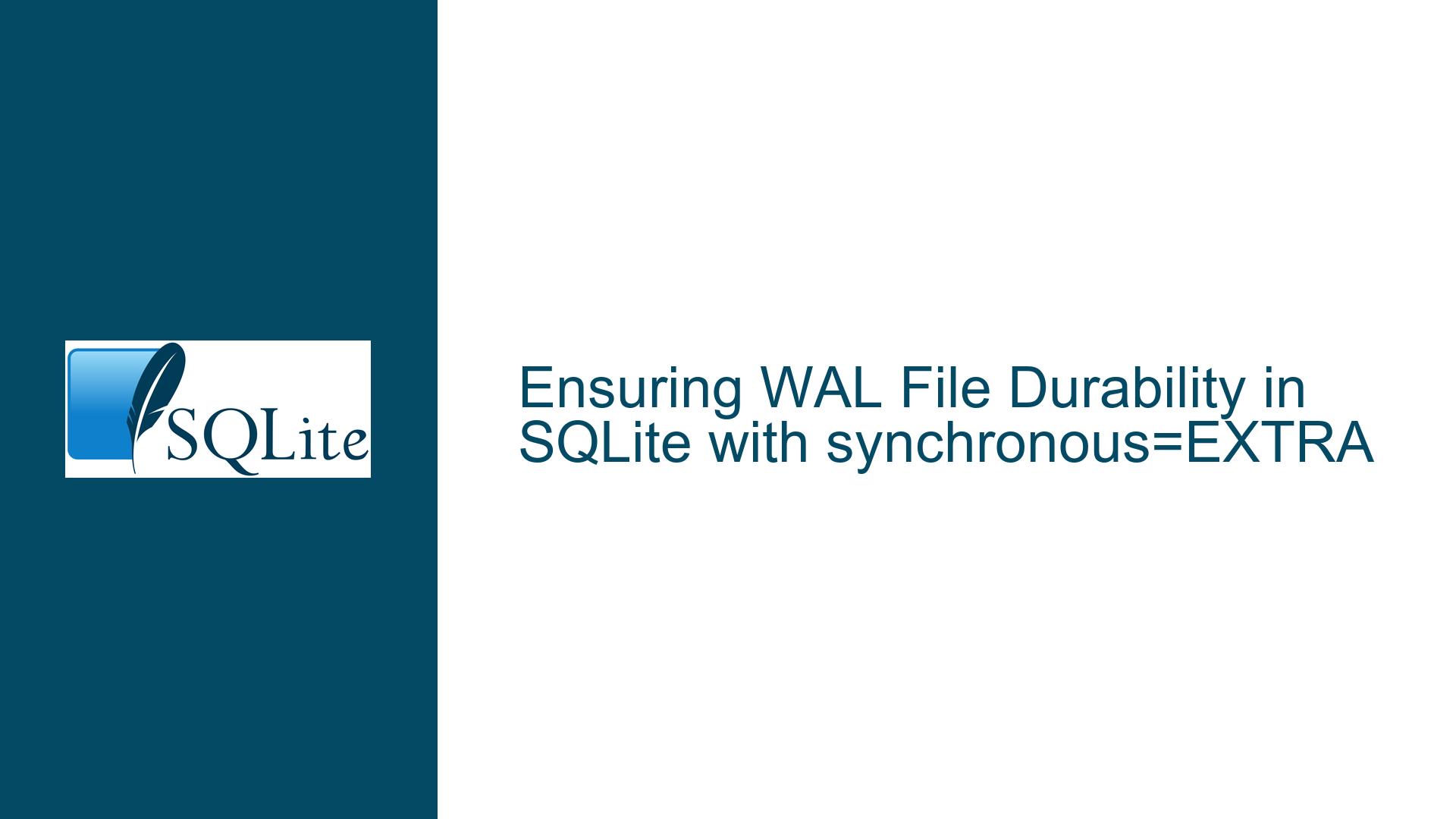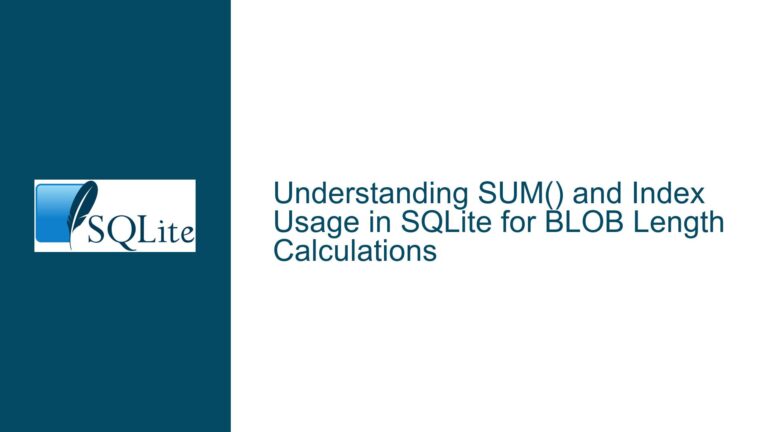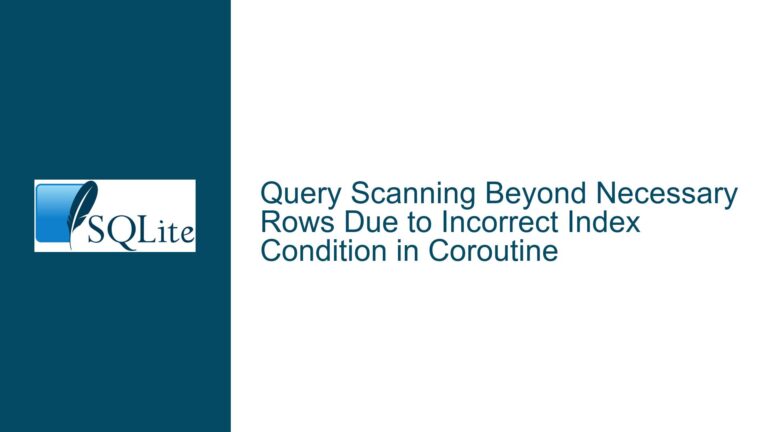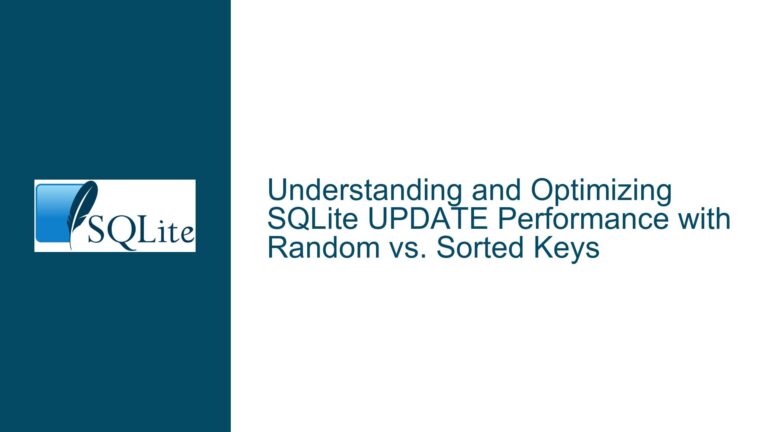Ensuring WAL File Durability in SQLite with synchronous=EXTRA
WAL File Creation and Directory Syncing in SQLite
When working with SQLite in Write-Ahead Logging (WAL) mode, one of the critical concerns is ensuring the durability of the WAL file, especially when the database is configured with synchronous=EXTRA. The WAL file is a crucial component of SQLite’s WAL mode, as it contains the changes that have not yet been committed to the main database file. The durability of this file is paramount, particularly in scenarios where the system might experience a power failure or crash immediately after a commit operation.
The primary issue revolves around the creation of the WAL file and whether SQLite ensures that the directory containing the WAL file is synced to disk when the file is first created. This is particularly important on POSIX systems, where the file system’s behavior might not guarantee that a newly created file is immediately visible in the directory after a crash. If the directory is not synced, a power failure could result in a situation where the WAL file is fully committed to disk, but the directory entry for the file is lost, leading to potential data inconsistency.
SQLite addresses this concern by setting the UNIXFILE_DIRSYNC flag on the file object internally when a journal or WAL file is opened with the SQLITE_OPEN_CREATE flag. This flag ensures that the directory is synced the first time SQLite attempts to sync the file itself. This behavior is consistent across all synchronous modes, including synchronous=EXTRA, and applies to both rollback and WAL journals, with the exception of temporary databases.
The WAL file is created when the sqlite_open*() functions are called, and it remains active for the duration of the database connection. This means that the durability of the WAL file is ensured from the moment it is created, provided that the directory syncing mechanism is in place. This mechanism is critical for maintaining data integrity, especially in high-durability scenarios where even the slightest chance of data loss is unacceptable.
Potential Risks of WAL File Deletion and Recovery
Another aspect of WAL file durability is the process of deleting the WAL file during a checkpoint operation. When SQLite performs a checkpoint, it transfers the changes from the WAL file to the main database file and then deletes the WAL file. The concern here is whether SQLite ensures that both the WAL file and the directory are synced before the deletion occurs, to prevent data loss in the event of a crash.
SQLite handles this by syncing both the WAL file and the directory before deleting the WAL file. In the event of a crash, SQLite can determine whether the database has been fully updated by examining the WAL file. If the WAL file still exists after a crash, SQLite will reapply the changes from the WAL file to the database during recovery. This process ensures that no data is lost, even if the system crashes during the checkpoint operation.
However, it’s important to note that reapplying the changes from the WAL file to the database is a redundant operation if the database has already been updated. This redundancy is a waste of resources but does not cause any harm to the data integrity. The key takeaway is that SQLite’s WAL mode is designed to ensure that data is not lost, even in the face of system crashes or power failures.
Implementing Exclusive Locking and Avoiding Shared Memory WAL-Index
In addition to ensuring the durability of the WAL file, another consideration when using SQLite in WAL mode is the use of exclusive locking to avoid the shared memory WAL-index. The WAL-index is a shared memory region used by SQLite to track the state of the WAL file. However, in some scenarios, it may be desirable to avoid using shared memory, particularly when exclusive locking is required.
By setting exclusive locking as the default at compile time, you can ensure that the -shm file (which contains the shared memory WAL-index) is never used. This is because exclusive locking is enforced at the database connection level, and SQLite will not create or use the -shm file when exclusive locking is enabled. This approach is particularly useful in environments where shared memory is not desirable or where exclusive access to the database is required.
It’s worth noting that while exclusive locking can improve performance by reducing contention for the WAL-index, it also limits the ability of multiple connections to access the database concurrently. Therefore, this approach should be used judiciously, depending on the specific requirements of your application.
Snapshot Isolation and Write Skew in WAL Mode
One of the key features of SQLite’s WAL mode is snapshot isolation, which allows read transactions to proceed without being blocked by write transactions. However, this isolation level can lead to a phenomenon known as write skew, where two transactions read the same data, make conflicting changes, and then commit those changes without being aware of each other’s modifications.
In SQLite, if a write statement occurs while a read transaction is active, the read transaction is upgraded to a write transaction if possible. However, if another database connection has already modified the database or is in the process of modifying it, the upgrade to a write transaction will fail, and the write statement will return an SQLITE_BUSY error. This behavior is a safeguard against write skew, ensuring that conflicting changes are not committed without proper synchronization.
For applications that require extreme durability and consistency, this behavior is beneficial, as it prevents data inconsistencies that could arise from write skew. However, it also means that applications must be designed to handle SQLITE_BUSY errors appropriately, either by retrying the transaction or by implementing a more sophisticated concurrency control mechanism.
Future Considerations: WAL2 Mode
Looking ahead, there is ongoing development in SQLite to introduce WAL2 mode, which promises to further enhance the durability and performance of WAL mode. While WAL2 mode is not yet generally available, it represents a potential future improvement that could address some of the limitations of the current WAL implementation.
WAL2 mode is expected to offer better performance and durability by introducing a second WAL file, which would allow for more efficient checkpointing and recovery. This could be particularly beneficial for applications that require extreme durability, as it would provide an additional layer of protection against data loss in the event of a crash.
In conclusion, SQLite’s WAL mode, when configured with synchronous=EXTRA, provides a robust mechanism for ensuring data durability, even in the face of system crashes or power failures. By understanding the nuances of WAL file creation, deletion, and recovery, as well as the implications of exclusive locking and snapshot isolation, developers can design applications that leverage SQLite’s durability features effectively. As SQLite continues to evolve, future enhancements like WAL2 mode may offer even greater levels of performance and reliability for demanding applications.






